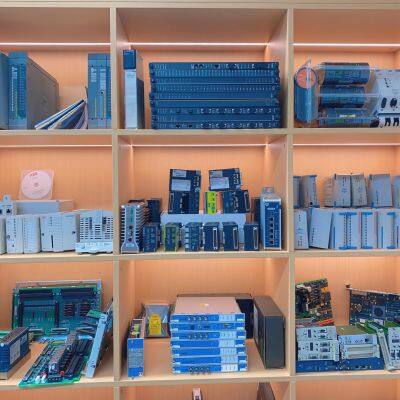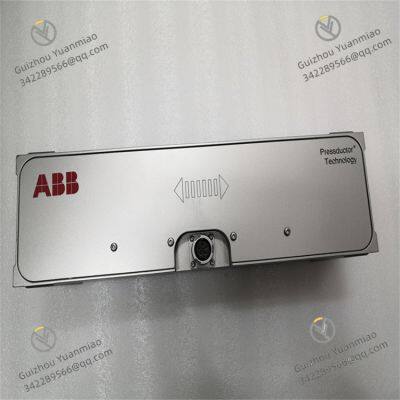Product Description
I. Overview
The ABB PFCL201CE-10.0kN is a medium-range, high-precision intelligent tension sensor. Its core positioning is to address the needs for accurate tension measurement and intelligent management during the production of medium-load coiled materials (such as thick steel plates, heavy-duty paper, rubber coils, and medium-sized cables), providing integrated "measurement-diagnosis-communication" data support for medium-tension closed-loop control. With a rated measurement range of 10.0kN (kilonewtons), it adopts a reinforced strain gauge structure and an intelligent signal processing unit, integrating high precision, high rigidity, and intelligent connectivity features. It is widely used in medium-load production lines across industries including metallurgy (e.g., medium and heavy plate rolling), papermaking (e.g., kraft paper production), rubber (e.g., tire tread coils), and cables (e.g., power cables). It can effectively prevent material stretching deformation, loose winding, or equipment overload caused by tension fluctuations, ensuring the production quality and continuous operation efficiency of medium-weight coiled materials.
This sensor features a compact reinforced structural design (external dimensions approximately 160mm×100mm×65mm, depending on the installation method). Its housing is made of high-strength 316L stainless steel (with surface passivation treatment), balancing structural rigidity (elastic body yield strength ≥ 800MPa) and corrosion resistance. It has an IP67 protection rating, capable of withstanding dust, coolant splashes, and short-term water immersion in industrial sites. Equipped with a built-in intelligent signal processing unit, it supports multi-signal output and remote diagnosis. It operates within a temperature range of -20℃~80℃, adapting to complex environments such as high temperatures in metallurgical workshops and high humidity in papermaking workshops. The signal output supports 4-20mA DC standard signals, RS485 digital signals (Modbus RTU protocol), and optional PROFINET industrial Ethernet. It can be directly connected to ABB AC500 PLCs, third-party DCS systems, or industrial Internet platforms, meeting the strict requirements of medium-load production lines for "high precision, high reliability, and high connectivity" in tension measurement.

II. Functional Features
1. Medium-Range High-Precision Tension Measurement
Tailored to the characteristics of medium-load tension, the PFCL201CE-10.0kN achieves excellent measurement performance through structural optimization and refined signal processing:
Ultra-High Measurement Precision: The measurement accuracy reaches ±0.08% FS (Full Scale), with a linear error ≤ 0.04% FS and a hysteresis error ≤ 0.03% FS. The minimum resolution within the 10.0kN range is 0.1N. For example, in a rolling production line for medium and heavy steel plates (thickness 5-10mm), when the steel plate tension fluctuates from 6kN to 6.2kN, the sensor can output a current signal in real time from 13.6mA (corresponding to 6kN) to 14.08mA (corresponding to 6.2kN), with an error ≤ 0.008mA. This provides an accurate adjustment basis for the controller, preventing thickness deviations (≤ 0.05mm) of the steel plate caused by uneven tension.
High Rigidity and Impact Resistance: The elastic body is made of 40CrNiMoA high-strength alloy steel, subjected to quenching and tempering treatment (hardness HRC30-35), with rigidity increased by 30% compared to conventional sensors. It can withstand continuous pressure and instantaneous impacts from medium-load coiled materials (such as 12kN instantaneous tension when coil joints pass through). After long-term use (≥ 6 years), the elastic body shows no plastic deformation, and the measurement accuracy attenuation is ≤ 0.05% FS.
Stable Output Across Wide Temperature Range: It uses low-temperature-drift strain gauges (temperature coefficient ≤ 0.0003% FS/℃) and a two-stage temperature compensation circuit. Within the operating temperature range of -20℃~80℃, the temperature drift is ≤ 0.001% FS/℃. For instance, in a metallurgical workshop with high summer temperatures (50℃) and low winter temperatures (-10℃), the change in measurement error is only ≤ 0.08% FS, much lower than the 0.15% FS temperature drift of conventional medium-range sensors, ensuring measurement stability across the entire temperature range.
2. Reinforced Structure and Environmental Adaptability
To cope with the complex working conditions of medium-load production lines, the sensor enhances reliability and environmental resistance through multiple structural designs:
IP67 Protection and Corrosion Resistance: The housing is made of 316L stainless steel, and after passivation treatment, its surface salt spray resistance meets the ASTM B117 standard (no corrosion for 1000 hours). The IP67 protection rating prevents coolant splashes in metallurgical workshops, moisture intrusion in papermaking workshops, and even short-term water immersion (30 minutes at 1m water depth), avoiding short circuits in internal circuits or component corrosion.
Vibration and Impact Resistance: The structural design complies with the IEC 60068-2-6 vibration standard (10-2000Hz, acceleration 10g) and the IEC 60068-2-27 impact standard (50g, 11ms). It can adapt to equipment vibrations in medium and heavy plate production lines (such as rolling mill vibration frequency of 50Hz), with sensor output signal fluctuation ≤ 0.01mA, avoiding tension misjudgment caused by vibration.
Overload Protection and Self-Protection: It has a short-term overload capacity of 150% FS (15kN) and a long-term overload capacity of 120% FS (12kN). A built-in overload protection circuit automatically cuts off the high-gain amplifier circuit and outputs a fixed fault signal (22mA) when the tension exceeds 15kN, while locking the measured value to prevent overload damage to the elastic body. For example, in power cable traction, if the cable jams and causes the tension to rise sharply to 14kN, the sensor can withstand it normally and issue an alarm, avoiding permanent damage.
3. Intelligent Diagnosis and Multi-Mode Communication
The sensor integrates an intelligent signal processing unit, breaking through the "single measurement" function of traditional tension sensors and realizing integrated "measurement-diagnosis-connectivity":
Full-Link Fault Diagnosis: It has three built-in functions: power supply monitoring, strain gauge status detection, and communication link diagnosis. It can real-time detect faults such as power overvoltage (> 30V DC), undervoltage (<18V DC), strain gauge open/short circuit, and RS485 communication interruption. While outputting a fault signal, it uploads fault codes (e.g., "E02: Strain Gauge Short Circuit", "E05: PROFINET Communication Interruption") through the digital interface. Maintenance personnel can quickly locate faults via upper computer software, reducing troubleshooting time by 60%.
Multi-Signal Output and Connectivity: It supports three signal output modes: ① 4-20mA DC analog signal (compatible with traditional control systems); ② RS485 digital signal (Modbus RTU protocol, transmission rate 9600-115200bps, capable of transmitting tension values, fault codes, and temperature compensation parameters); ③ Optional PROFINET industrial Ethernet (transmission rate 100Mbps, supporting high-speed upload of real-time tension data and diagnostic information). For example, in an intelligent papermaking plant, the sensor connects to the factory's industrial Internet platform via PROFINET to upload kraft paper winding tension data in real time, allowing the platform to remotely monitor tension trends and predict maintenance needs.
Remote Parameter Configuration: Through RS485 or PROFINET interfaces, parameters such as sensor sampling rate (adjustable 50Hz-500Hz), filter bandwidth (10Hz-200Hz), and fault thresholds (e.g., overload alarm threshold of 12kN) can be configured remotely without on-site sensor disassembly. This adapts to the maintenance needs of medium-load production lines for "fewer shutdowns and faster adjustments". For example, in tire tread coil production, when changing coil specifications, maintenance personnel can adjust the tension measurement range via remote configuration without shutdown calibration.
4. Flexible Installation and Convenient Maintenance
In response to the diverse equipment layouts and high maintenance difficulty of medium-load production lines, the sensor optimizes installation and maintenance design:
Adaptability to Multiple Installation Methods: It supports three installation methods—flange mounting, pin mounting, and double-ear suspension mounting—to adapt to different mechanical structures of medium-load tension rollers and winders. For example, at the exit of a medium and heavy plate rolling mill, flange mounting is used to fix the sensor next to the tension roller bearing seat for direct measurement of steel plate tension; on cable traction equipment, double-ear suspension mounting is used to hoist the sensor above the traction roller, adapting to high-altitude installation scenarios.
Standardized Interface and Anti-Misinsertion: It uses an M12 circular connector (5-core, with anti-misinsertion key design). The wiring distinguishes between power supply, analog signals, and digital signals to avoid circuit damage caused by reverse connection of positive and negative poles or signal confusion. The connector has an IP67 protection rating, consistent with the sensor body, ensuring overall protection performance.
On-Site Rapid Calibration: It supports three calibration modes—"zero calibration", "two-point calibration", and "remote calibration": Zero calibration can be completed by short-pressing the button on the sensor side for 3 seconds (under no-load condition); two-point calibration requires inputting standard tension values (e.g., hanging 5kN and 10kN weights) via ABB calibration software; remote calibration can issue calibration commands through the PROFINET interface. The calibration process takes ≤ 5 minutes and can be completed by production line operators without the need for a professional calibration team.

III. Technical Parameters
Electrical Parameters
2. Mechanical and Environmental Parameters
3. Reliability and Certification Parameters
Fatigue Life: ≥ 12 million full-scale cycles (in accordance with ISO 3808 medium-load standard);
Mean Time Between Failures (MTBF): ≥ 60,000 hours;
Certification Standards: CE Certification (EN 61326-1), Optional ATEX Certification (for explosive environments), RoHS 2.0 Certification;
Material Certification: 316L stainless steel complies with ASTM A240 standard; Elastic body complies with EN 10083-3 standard.
IV. Working Principle
The PFCL201CE-10.0kN is based on the reinforced strain gauge measurement principle and integrates an intelligent signal processing unit. Its working process revolves around the sequence of "medium tension force application - strain sensing - intelligent signal processing - multi-mode output - closed-loop control", which is detailed as follows:
Medium Tension Force Application Stage: When medium-load coiled materials (e.g., medium and heavy steel plates, kraft paper) pass through the tension roller, the 10kN-level tension is transmitted to the sensor’s elastic body (40CrNiMoA alloy steel). The elastic body undergoes slight elastic deformation under tension (approximately 0.08mm deformation under 10kN tension). Although the deformation is small, the rigidity is sufficient to avoid plastic deformation risks.
Strain Sensing Stage: Four high-precision metal strain gauges are bonded to the surface of the elastic body (forming a full-bridge circuit to improve signal sensitivity). As the elastic body deforms, the strain gauges produce resistance changes—tensile strain gauges show increased resistance, while compressive strain gauges show decreased resistance. The full-bridge circuit outputs a weak mV-level voltage signal (the signal amplitude is twice that of a half-bridge circuit, with stronger anti-interference capability).
Intelligent Signal Processing Stage: The built-in intelligent signal processing unit processes the mV-level signal: ① Amplifies the signal to the V level via a low-noise amplifier; ② Uses a 200Hz low-pass filter circuit to eliminate vibration noise from medium-load equipment (e.g., rolling mill vibration); ③ Uses a two-stage temperature compensation circuit to offset the impact of temperature on the elastic body and strain gauges; ④ A microprocessor performs linear calibration and fault judgment on the signal to generate accurate tension data and status information.
Multi-Mode Signal Output Stage: The processed tension data is output in three ways: ① Converted to a 4-20mA DC analog signal via a 16-bit D/A converter (4mA corresponding to 0kN, 20mA corresponding to 10kN); ② Outputs digital tension values and fault codes through the RS485 interface; ③ Uploads real-time data to the industrial Internet platform at high speed via the optional PROFINET interface.
Closed-Loop Control Stage: The controller (e.g., ABB AC500 PLC) receives the tension data and compares the actual value with the set value (e.g., 8kN set tension for medium and heavy plates). If the actual tension (8.5kN) is greater than the set value, it drives the actuator (e.g., adjusting the winding speed via a frequency converter, adjusting the tension roller pressure via a hydraulic cylinder) to reduce the tension; if the actual tension (7.5kN) is less than the set value, it increases the tension. This ensures that the tension of the medium-load coiled material is stabilized within ±0.04kN, avoiding damage to materials or equipment.


ABB HIEE305114R00R0001 PCB Board
ABB PVD164A2059 3BHE014340R2059 Excitation Controller
ABB EST125-975 DCC2382A Drive Control Unit
ABB Synchrotact5 SYN5302a-Z,V217 Digital Synchronizer
ABB 3BHB006716R0217 Digital Synchronizer
ABB Synchrotact5 SYN5302a-Z,V277 Digital Synchronizer
ABB 3BHB006716R0277 Digital Synchronizer
GE IS200AEADH1AAA Input/Output Grid Fork Board
Basler Electric DECS125-15-B1 Digital Excitation Controller
BENTLY NEVADA 3701/55 ADAPT Condition Monitor
GE L90-W03-HKH-F8L-H6P-L6C-N6C-S6C-U6L-W7G Multilin L90 protector
ABB PM863K01 3BSE088381R1 AC 800M processor unit Controller
 yezi
Hi there! Welcome to my shop. Let me know if you have any questions.
yezi
Hi there! Welcome to my shop. Let me know if you have any questions.




